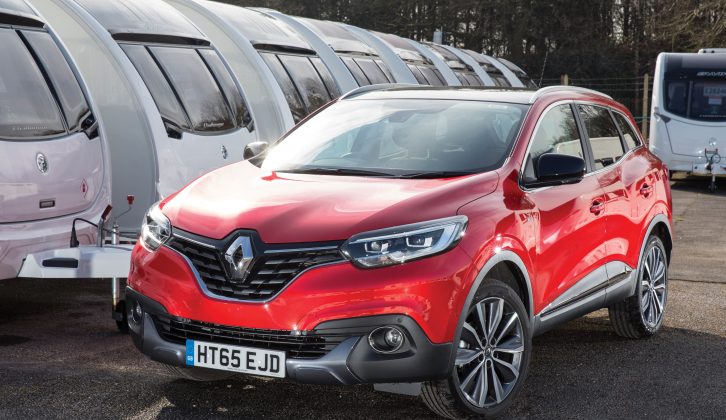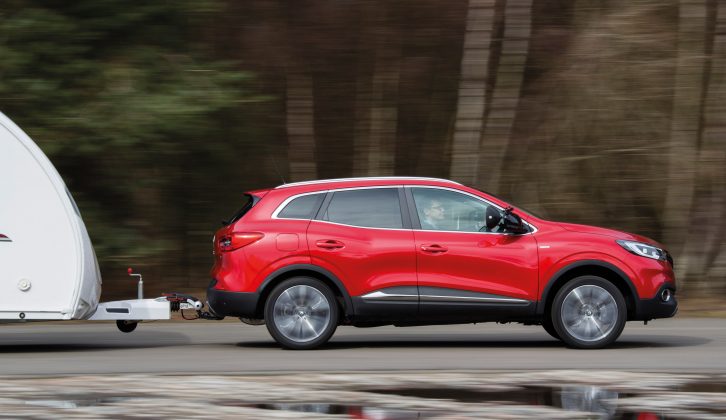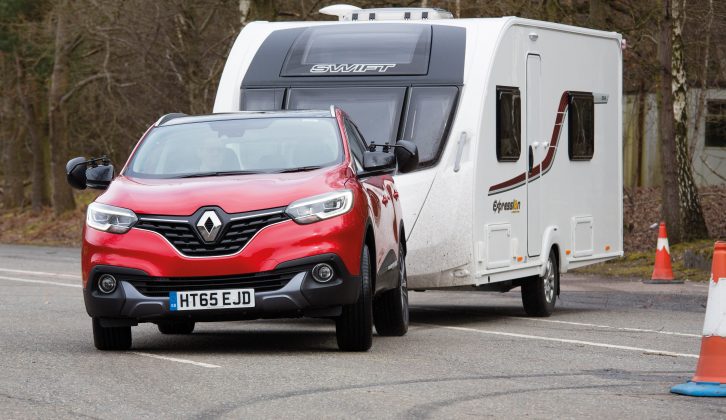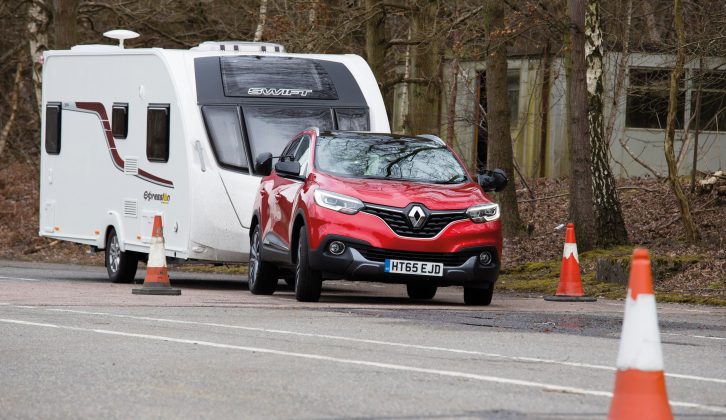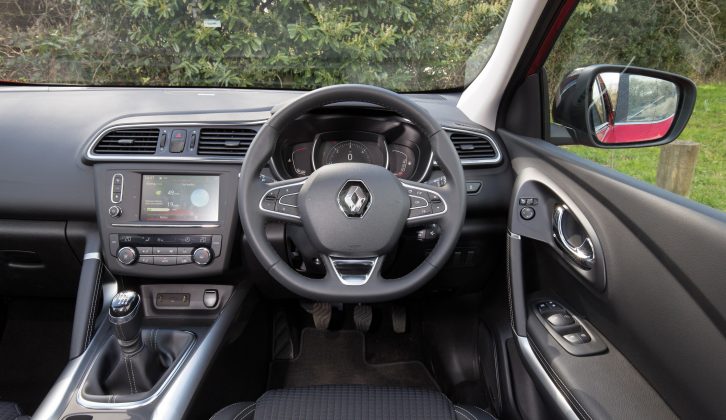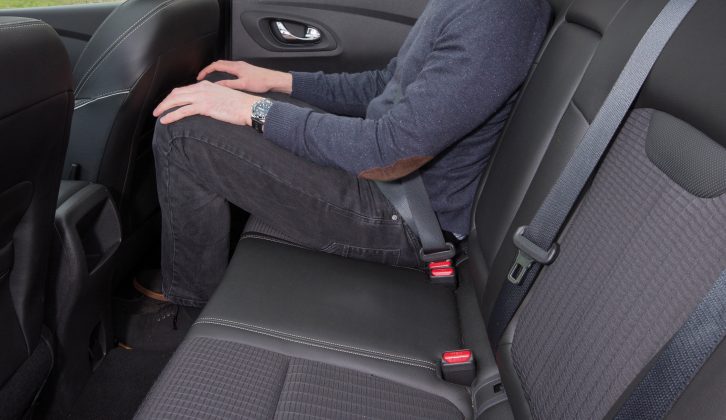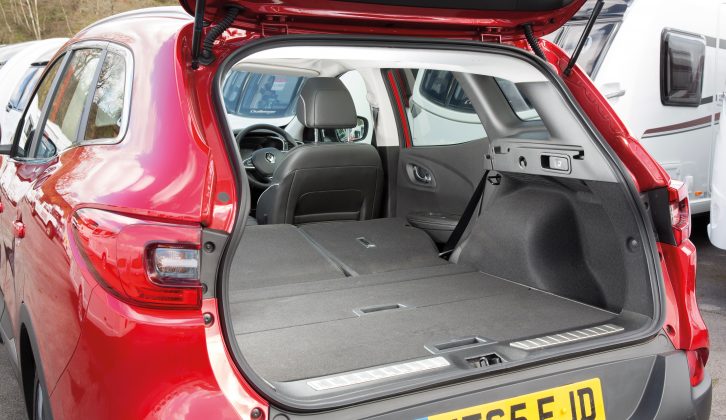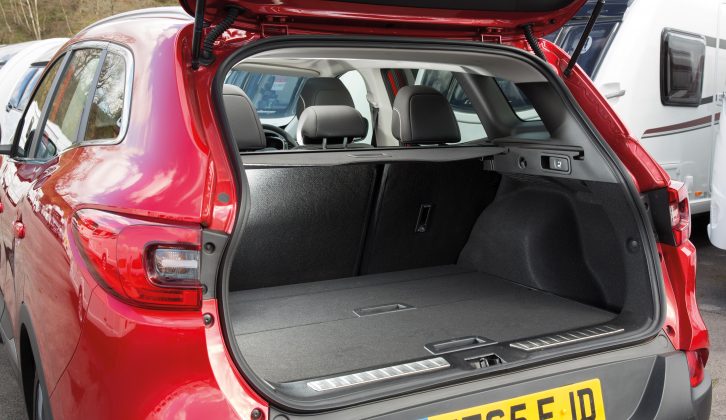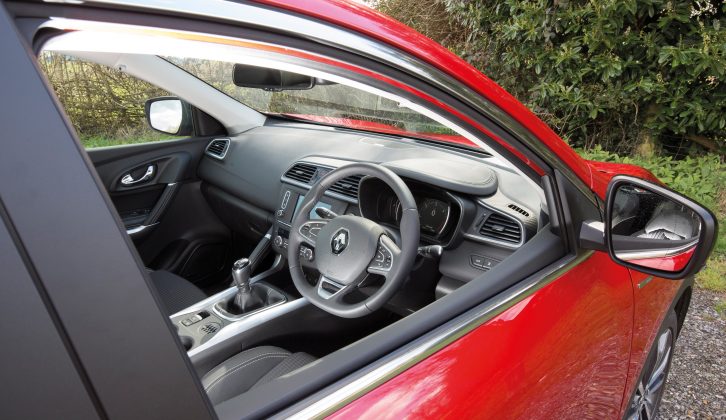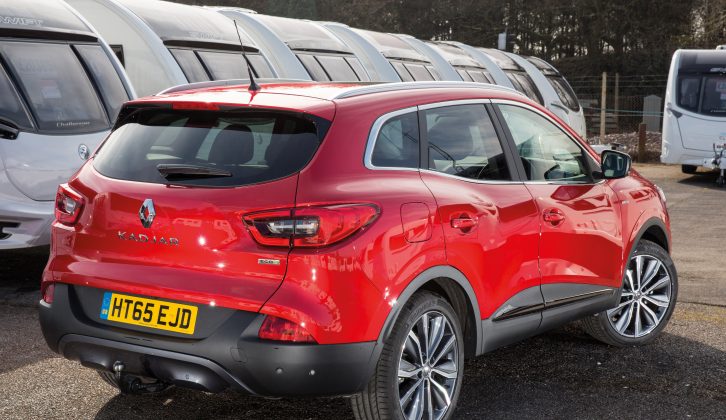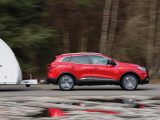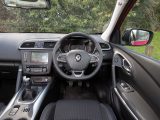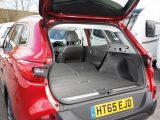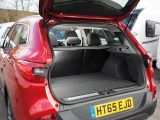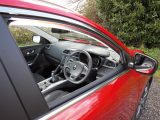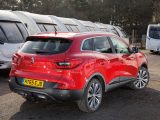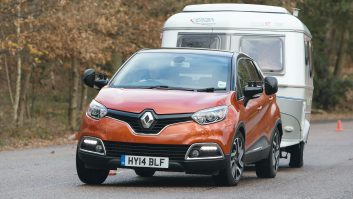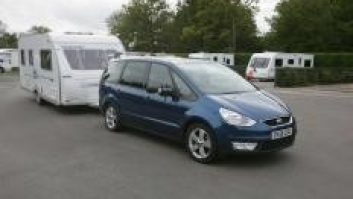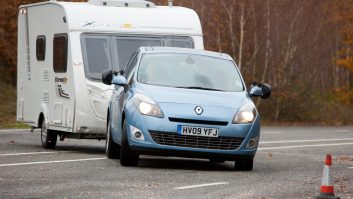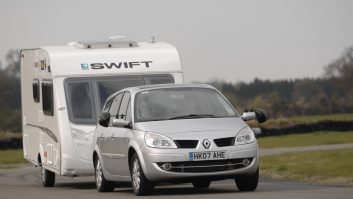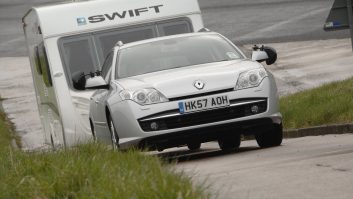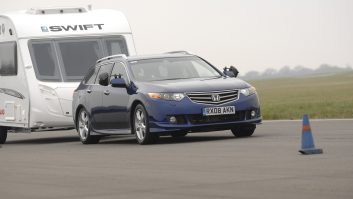Verdict
The Renault Kadjar is very good indeed. In this spec it has limitations as a tow car, however.
With 192lb ft of torque, the engine is short of pulling power for towing at speed on hilly roads. There’s enough performance to hold 60mph on the motorway but, if you want to maintain a decent pace up a steep hill or overtake dawdling traffic, the 1.5-litre diesel starts to struggle.
Some caravanners with a lightweight van might decide that the steady performance is a price worth paying for engine refinement and fuel economy. And, if they do, the Kadjar has many redeeming features.
At the legal limit the car is stable, only moving around slightly in a strong crosswind. It handled our lane-change test well and coped with the hill-start, despite its modest power.
The 1.5-litre engine performs much better in everyday driving than when towing, and it delivers good fuel economy. We’ve driven almost 600 miles between fill-ups in regular driving.
The Kadjar is roomy as well as fuel-efficient. The driver and front-seat passenger have plenty of space in a cabin that’s well made and attractively designed.
Rear-seat space is good, too, and there’s more luggage room than you’ll find in the Nissan Qashqai, the Renault’s key rival. What’s more, the false floor and easy-folding rear seats make the luggage compartment impressively flexible.
We like the Kadjar a lot, but we strongly suspect that we’ll like the more powerful four-wheel-drive version even better.
Pros
Towing fuel economy: 34.6mpg
Solo driving: 50-72mpg
Good leg-room, back and front
Good at lane-changing
Good for motorway towing, once up to speed
Stable in crosswinds
Cons
Needs air-vents for rear passengers
Sluggish acceleration when towing
Only 192lb ft of torque
Slow on hills when towing
Modest 1.5-litre engine
The new Renault Kadjar is the company’s first mid-sized crossover. Under the skin it’s a close relative of the Nissan Qashqai, the overall winner of the Tow Car Awards in 2014, so it has good tow car genes. This summer (2016) it’ll be the turn of the most powerful 4×4 version of the Kadjar to take a tilt at that title; but first we’re testing the 1.5-litre, two-wheel-drive diesel. It may not be as heavy or powerful, but it should cope with light caravans.
The Kadjar’s dCi 110 engine majors on fuel economy, but is it powerful enough for towing? What does the Kadjar have to offer when there are so many capable crossovers for buyers to choose from?
When towing the Swift on A-roads and motorways, the Kadjar returned a very impressive 34.6mpg
Towing
Which is more important in a tow car, stability or speed? We’d take stability every time, which in this case is just as well.
We matched the Kadjar to a Swift Expression 554 with a Mass in Running Order of 1197kg. That’s an 81% match for the Kadjar, and well within the Renault’s modest 1350kg legal towing limit. Even with a light caravan behind it the Kadjar felt sluggish, though, taking 20.6 seconds to go from 30-60mph. Our test car’s engine had covered fewer than 2000 miles, but we still expected a little more pace.
Work the gearbox and keep the engine between peak torque (192lb ft @ 1750rpm) and maximum power (108bhp/110PS @ 4000rpm), and performance is just about acceptable, but there’s very little going on at low revs.
When reviewing cars with a manual gearbox, one of our standard tests is to accelerate from 50-60mph one gear below the highest. In the case of the Kadjar that meant fifth, but we ran out of straight road before the Renault would pull the caravan up to the legal limit – blame gearing that’s chosen for fuel efficiency at motorway speeds rather than brisk acceleration. Progress was sedate even when we dropped to fourth gear, taking 17.1 seconds from 50mph to 60mph.
Despite this lethargy, the Kadjar coped reasonably well with the hill-start test. The electronic parking brake held car and caravan still on a 1-in-10 slope, and the car pulled to the top of the slope without fuss or any whiff of overheating clutch.
The Kadjar also put in a solid shift during the lane-change test. On the fastest runs we could hear and feel the stability control system applying the car’s brakes, but however hard we drove – and whatever corrective action the Kadjar’s electronic minder took – there was no pushing or shoving from the van.
At high speeds the Kadjar was secure in still air. In a strong crosswind the Renault fidgeted slightly, but it was nothing untoward. We were confident and happy in the car’s ability to keep a straight, stable course.
During regular towing we were also content with the car’s brakes, which felt strong and easy to apply smoothly. However, the 30-0mph stopping distance of 11 metres could have been better given the dry surface.
To sum up, the Renault Kadjar dCi 110 Signature Nav is a mixed bag as a tow car, and certainly with this engine. It’s stable, and the electronic parking brake helps make hill starts straightforward. But the engine is only just strong enough for towing at speed, especially on hilly roads. For regular towing or pulling a heavier van, the 1.6-litre 4×4 diesel looks a better bet.
Everyday Driving
Without a caravan in tow, the 1.5-litre engine doesn’t feel so lacking. In fact, as long as you don’t let the revs drop far below the 1750rpm torque peak, it seems much livelier than its towing performance would suggest. You sometimes need a lower gear than you’d expect – fifth and sixth in particular are very tall – but that’s easy for the driver to adjust to.
What’s more, the engine is quiet and refined. At a steady cruise it’s barely audible, and even under acceleration it sounds distant unless revved really hard. In fact, aside from some road noise, the Kadjar is a quiet and refined car, full stop. We’d be surprised if road noise wasn’t more subdued with smaller wheels, too (our Renault Kadjar Signature Nav test car has 19-inch alloys).
The latter might also improve ride comfort around town. The Kadjar can be caught out by sharp bumps at low speed, but it improves on faster roads, where it feels smooth and controlled.
Take the long way home and the Kadjar handles tidily. There’s some lean when it’s pushed in corners, but it’s not excessive; and, although the steering feels rather numb, it’s precise.
All-round visibility could be better, though. You notice how thick the windscreen pillars are at angled junctions, and the view behind isn’t great when you’re reversing. Fortunately, front and rear parking sensors are standard on Signature Nav cars.
It may not spring surprises or do anything a Qashqai doesn’t, but the Kadjar is a very pleasant car to live with day-to-day.
Space
Renault has made great strides with cabin quality in recent years, and the Kadjar is a good example. The dashboard looks and feels solidly put together from quality materials, and the design is simple and attractive. Many functions are accessed via the touchscreen infotainment system, but Renault has sensibly kept the controls for the air-conditioning separate, so they are easy to use on the move.
There’s plenty of space, too. Tall drivers can be accommodated easily enough, even with the panoramic sunroof fitted in the car, and there’s lots of adjustment for the seat and wheel.
Despite the sunroof, headroom doesn’t suffer too much in the rear, either. There’s also plenty of legroom, so a six-feet-tall passenger can travel in comfort behind an equally long-limbed driver. The chunky transmission tunnel – necessary for 4×4 versions of the Kadjar – does get in the way if you’re travelling with a trio of rear passengers, but the cabin is wide enough for three to sit in the back without too much of a squeeze. We’d be even happier if there were air vents between the front seats or in the door pillars.
The Kadjar is a touch longer than the Nissan Qashqai, and has 472 litres of boot space – that’s 42 more than in the Nissan. There’s a false floor under which items can be hidden, or the top level can be taken out in two pieces and used to divide the boot into separate spaces. Levers on either side of the tailgate fold the seats down in one easy movement, increasing the overall capacity to 1478 litres. There’s only a slight slope to the load floor as a result.
Aside from the lack of rear air vents, the Kadjar is a very practical crossover.
Running Costs
Our top-spec Kadjar Signature Nav costs £24,195 if you pay the list price. However, research by our colleagues on What Car? suggests that buyers can knock more than £2000 from that figure with a little persuasion. That’s a big discount on a car that’s only been on sale for a few months.
The car sits in insurance group 15E, so premiums ought to be affordable, while the Kadjar returns 72.4mpg on the combined cycle. Cars with the same engine but riding on smaller alloy wheels improve that figure to 74.3mpg.
As you’d expect, very few drivers will match those numbers in everyday driving. In our time with the car we averaged between 50 and 55mpg, depending on the traffic conditions. When towing the Swift on A-roads and motorways, the Kadjar returned a very impressive 34.6mpg.
Go for Signature Nav spec, and you’ll have a long list of toys to play with between trips to the filling station. There’s a powerful Bose stereo with seven speakers, an R-Link multimedia system with a seven-inch touchscreen and satellite navigation, dual-zone climate control and a panoramic sunroof.
Safety aids on this model include a lane-departure warning system, traffic-sign recognition and automatic switching between high and low beams. The car also has stability control and driver, passenger, side and curtain airbags, all of which contributed to its five-star Euro NCAP rating.
What Car? expects the Kadjar to be worth 43% of the original list price after three years and 36,000 miles. That’s not bad, but some rivals hold their value better.
Technical Specifications
| Engine Size | 1461 cc |
| Kerbweight | 1469 kg |
| 85% KW | 1249 kg |
| Towball Limit | 75 kg |
| Maximum Towing Limit | 3274 kg |
| Power | 108 bhp |
| Torque | 192 lb ft |
| Offical MPG | 72.4 mpg |
| CO₂ | 103 g/km |
